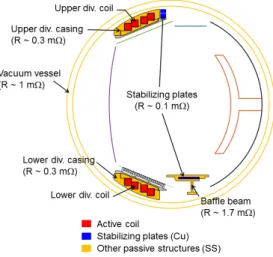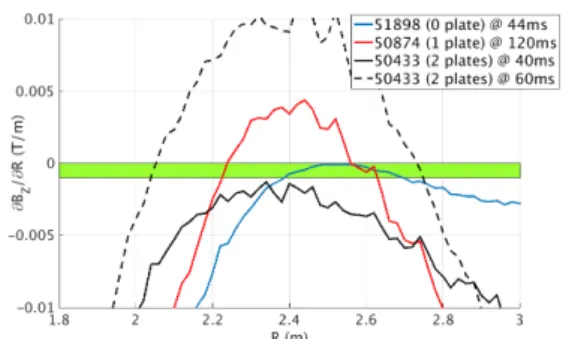HAL Id: hal-01959689
https://hal.archives-ouvertes.fr/hal-01959689
Submitted on 18 Dec 2018HAL is a multi-disciplinary open access archive for the deposit and dissemination of sci-entific research documents, whether they are pub-lished or not. The documents may come from teaching and research institutions in France or abroad, or from public or private research centers.
L’archive ouverte pluridisciplinaire HAL, est destinée au dépôt et à la diffusion de documents scientifiques de niveau recherche, publiés ou non, émanant des établissements d’enseignement et de recherche français ou étrangers, des laboratoires publics ou privés.
WEST tokamak
E. Nardon, Holger Heumann, J. Artaud, J. Bucalossi, D Douai, N. Fedorczak,
T. Loarer, P. Moreau, R. Nouailletas, C. Reux, et al.
To cite this version:
E. Nardon, Holger Heumann, J. Artaud, J. Bucalossi, D Douai, et al.. Magnetic configuration and plasma start-up in the WEST tokamak. 45th EPS Conference on Plasma Physics, 2018, Prague, Czech Republic. �hal-01959689�
Magnetic configuration and plasma start-up in the WEST tokamak
E. Nardon1, H. Heumann2, J.F. Artaud1, J. Bucalossi1, D. Douai1, N. Fedorczak1, T. Loarer1, P. Moreau1, R. Nouailletas1, C. Reux1, F. Saint-Laurent1, P. Tamain1and the WEST team∗
1CEA, IRFM, F-13108 Saint-Paul-lez-Durance, France
2TEAM CASTOR, INRIA, 2004 Route des Lucioles, BP 93, 06902 Sophia Antipolis Cedex,
France and Laboratoire J.A. Dieudonné, UMR 7351, Université de Nice Sophia Antipolis, Parc Valrose, 06108 Nice Cedex 02, France
Introduction
This paper describes experimental findings regarding plasma inductive start-up [1][2] in the first year of operation of the WEST tokamak [3]. The results are interpreted with the help of modelling and compared to criteria for a successful start-up from the literature [1][4]. The focus here is on magnetic configuration aspects. Other aspects, in particular burn-through and runaway electron production, will be discussed in a future paper.
Magnetic field requirements for a successful inductive start-up
A successful inductive start-up begins with a breakdown followed by a rise of the plasma current Ip. For this to happen, the poloidal magnetic field ~Bpneeds to fulfill a number of
con-ditions [1][4]. First, the breakdown requires a region of low Bp (a ‘field null region’) in order
for electrons to be accelerated by the toroidal electric field E for many turns before hitting the wall. A quantitative criterion established across many tokamaks is ELe f f > 70V [4], where
Le f f = 0.25ae f fBt/ < Bp> is the effective field line connection length, with ae f f the minor ra-dius of the field-null region and < Bp> the averaged poloidal field at the null region boundary.
Then, the parallel current density j generated by the breakdown should be sufficient to create closed flux surfaces. Finally, plasma radial force balance requires the vertical field BZ to be
ramped up in proportion to Ip, and plasma positional stability requires the vertical field decay
index n ≡ −(R/BZ)∂ BZ/∂ R to be both > 0 for vertical stability and < 3/2 for radial stability
[5].
The route to a successful start-up in WEST
WEST [3] is a modification of the Tore Supra tokamak based on adding two in-vessel coils (in red in Figure 1) in order to allow diverted configurations, and changing all plasma facing
components from carbon to tungsten (W), including actively cooled W monoblocs for the di-vertor target in order to test the technology to be used in ITER. The didi-vertor coils are inserted inside thick casings (in yellow in Figure 1) which constitute axisymmetric passive conducting structures (∼ 0.3mΩ each). In addition, two copper stabilizing “plates” (∼ 0.1mΩ each, in blue in Figure 1) were added in the upper and lower region of the vessel to increase the accessible elongation range.
Figure 1:WEST vacuum vessel configuration
Operation on WEST started in December 2016. Although breakdown was achieved easily from the first days, Ip would not take off in spite of many
adjustments of the settings (gas prefill, premagne-tization coils currents, power supplies voltages). It was suspected early on that the problem came from induced currents in the stabilizing plates perturbing the ~Bp map. After about two months of operation with no successful start-up in the initial (2 plates) configuration, the lower stabilizing plate was
there-fore removed in June 2017. One month of operation in this second (1 plate) configuration did not lead to successful start-up either, so in October 2017 the upper stabilizing plate was segmented into 6 pieces to strongly reduce induced currents (it would have been much more difficult to remove the plate). After one month of operation in this third (0 plate) configuration, successful start-up was finally achieved in November 2017.
Figure 2: FEEQS.M magnetic flux contours (white dashed lines) overlayed on a fast camera image for a start-up attempt in the 2 plates configuration (initial currents have been tweaked by ±100A in four of the coils in FEEQS.M to improve the match).
It is important to mention that start-up issues were most likely not due to bad settings but really to machine configuration. Indeed, start-up settings were carefully optimized with the FEEQS.M free-boundary equilibrium code [6] in “plasma-less, in-verse time evolution” mode (accounting for the ef-fect of the iron core).
Interpretative modelling method
In order to interprete experimental results, we re-construct the magnetic field map with two differ-ent approaches: direct time evolution of Maxwell’s equations with the above-mentioned FEEQS.M code [6], or identification based on magnetic
mea-surements with the FREEBIE-ID code [7]. The two methods give results consistent with each other as well as with fast visible tangential camera images, as illustrated in Figure 2. FREEBIE-ID has the advantage of identifying the plasma current.
Analysis of experimental cases
We now analyze one case from each phase of operation, namely shots 50433 (2 plates), 50874 (1 plate) and 51898 (0 plate). In each case, a successful plasma breakdown was obtained and maintained for 50ms or more, but only in the last case did Ip really take off. In the first two
cases, over most of the plasma duration, the light pattern on fast camera images does not show signs of closed flux surfaces. Only for a very brief period of the order of 1ms are closed flux surfaces visible, and they seem to be lost due to a positional instability.
Figure 3: Profile of ∂ BZ/∂ R at the vessel
midplane for 3 start-up attempts (see text for details). The green band indicates roughly the positional stability window.
According to the modelling, the breakdown cri-terion ELe f f > 70V [4] is fulfilled in all cases
(although not with much margin for the 1 and 2 plates cases), consistently with experimental obser-vations. The parallel current density j generated by the breakdown, as identified by FREEBIE-ID, is ∼ 10kA/m2. The magnetic field created by this j
appears marginal to close flux surfaces in the 1 and 2 plates cases, again in agreement with observations (here it is worth mentioning that it took many shot-to-shot adjustments to produce closed flux surfaces
in the 1 and 2 plates cases). Finally, positional stability is addressed by Figure 3, which presents, for the three cases, the ∂ BZ/∂ R profile at the vessel midplane calculated by FEEQS.M near the
time when closed flux surfaces are visible (plain lines). For the 2 plates case (black), a ∂ BZ/∂ R
profile is also shown 20ms later (dashed line) to stress the fast temporal evolution for this case (the other two cases evolve much more slowly). Inserting an estimate of the necessary BZ for
radial force balance [1] at Ip= 10kA (which is an upper bound according to FREEBIE-ID),
the above-mentioned stability criterion becomes −1mT/m < ∂ BZ/∂ R < 0, which is indicated
by the green band in Figure 3. Clearly, only the 0 plate case (blue) fulfills this criterion over a significant region. Once again, this is consistent with fast camera observations of positional instabilities in the 1 and 2 plates cases. We note that KSTAR reported positional stability issues at start-up [8].
Discussion and conclusion
In conclusion, inductive start-up in WEST was hindered by the presence of toroidally contin-uous copper stabilizing plates inside the vessel. One message of this paper is therefore that the insertion of such structures in future machines should be considered with great caution.
As we saw, the plates did not prevent plasma breakdown but made the closure of flux surfaces difficult, and positional stability apparently impossible. It therefore seems that there was an in-creasing level of difficulty in meeting the breakdown, flux surface closure, and positional sta-bility conditions. Simple estimates may “explain” this observation. A comparison between the three conditions can indeed be made by rewriting each of them in the form < Bp> /ae f f < X .
The ELe f f > 70V breakdown condition implies < Bp> /ae f f < 3 · 10−3EBt ≈ 11mT/m (for
typical WEST values E = 1V/m and Bt= 3.6T). Flux surfaces may close if the poloidal
mag-netic field generated by the plasma, ∼ µ0· j · ae f f/2, is larger than the vacuum field < Bp>, i.e.
if < Bp> /ae f f < µ0· j/2 ≈ 6mT/m (taking j = 10kA/m2as suggested by FREEBIE-ID).
Fi-nally, if we consider that |∂ BZ/∂ R| ∼< Bp> /ae f f, the stability condition at Ip= 10kA implies
< Bp> /ae f f < 1mT/m. Therefore, Xbreakdown= 11mT/m > Xclosure= 6mT/m > Xstability =
1mT/m.
This hierarchy, although it is clear in WEST, is not universal but depends on the values of E, Bt and j. Of these three quantities, j is obviously the most difficult one to estimate for future
devices. During the first year of operation of WEST, j seemed to saturate during the breakdown phase at lower values than those stated in [1][2]. This may be related to poor machine con-ditioning. Future experiments (with improving machine conditions) and analysis may confirm this hypothesis.
References
[1] D. Mueller, Phys. Plasmas 20 058101 (2013) [2] B. Lloyd et al., Nucl. Fusion 31 2031 (1991) [3] J. Bucalossi et al., Fusion Eng. Des. 89 907 (2014) [4] Y. Gribov et al., Nucl. Fusion 47 S385-S403 (2007)
[5] V.S. Mukhovatov and V.D. Shafranov, Nucl. Fusion 11 605 (1971)
[6] J. Blum, H. Heumann et al., “Automating the design of tokamak experiment scenarios”, in preparation [7] J-F. Artaud, private communication

